HOME : Birding in India : India Birding
INDIA BIRDING
India is one of the 12 megadiversity countries of the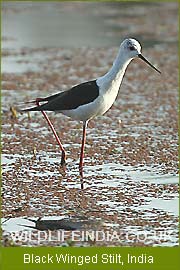 world.
There are numerous species, the potential of which is not yet known. Nearly
95 % of the medicines used in the traditional treatment in India are plant based.
India's land mass is 2.4 % of the total land area on this planet but its contribution
to world's biodiversity is app. 8% of the total number of species.
world.
There are numerous species, the potential of which is not yet known. Nearly
95 % of the medicines used in the traditional treatment in India are plant based.
India's land mass is 2.4 % of the total land area on this planet but its contribution
to world's biodiversity is app. 8% of the total number of species. India ranks tenth in the world & fourth in Asia in plant diversity and ranks tenth in the number of endemic species of higher vertebrates in the world. India has 11 biogeographical zones and has 6 types of natural habitats. Over 47,000 species of plants and 89,000 species of animals have been recorded in India. Out of 4700 species of plants, 5150 are endemic to India.
To protect & conserve its rich flora and fauna, 18 biodiversity rich areas have been designated as Biosphere Reserves. 7 sites in India fall under the preview as Natural World Heritage sites under the World Heritage Convention. Among the 18 hot spots in the world, two are in India namely The Eastern Himalayas and the Western Ghats.
India has over 350 species of mammals and over 1225 forms of birds, some of them are endemic to India only. Some of the unique species found in India are Golden Langur, Namdapha flying squirrel, Lion tailed macaque, Nilgiri Langur, Nilgiri Tahr, Flying Squirrel, Malabar Grey Hornbill, Asiatic Lion, Nilgai, the Spiral Horned Black Buck, the four horned Chausingha.
To protect this unique wildlife India has earmarked app. 4.2 % of the total geo-area for conversation. A protected area network of 104 National Parks and 551 wildlife sanctuaries have also been created.
Avifauna of India
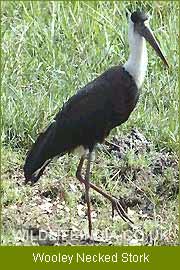
India, one of the 12 megadiversity countries, is very rich in biodiversity. Over 1200 species of birds comprising at least 13 % of the world's birds are found in India. Biogeographically, India is situated at the tri-junction of three realms namely Afro-tropical, Indo-Malayan and Paleo-Arctic realms, and therefore, has characteristic elements from each of them. This assemblage of three distinct realms probably is a fact which is believed to partly account for its rich and unique birdlife.
One of the main reasons for high density of birdlife in India is presence of diverse biographical zones classification of which has been attributed to Rogers and Pawar (1990). We take this classification to describe the avifauna of India.
1. Trans-Himalayas - An extension of the Tibetan plateau, harboring high-altitude cold desert in Ladakh and Lahaul Spiti comprises 5.7 % of the country's landmass. This area has many high altitude lakes and flat plains and serves as an important breeding ground for birds like Black-necked cranes, Bar-headed geese, Great Crested Grebe, Tibetan Sandgrouse, Horned Lark, The Tibetan Snowcock, Himalayan Griffen and Wheatears etc.
2. Himalayas - The entire mountain chain running from north-western to north-eastern India, comprising diverse range of biotic provinces and biomes covers 7.2 % of the country's landmass. Out of 49 species of pheasants, 18 are found in the Himalayan region (Ali & Ripley 1987).
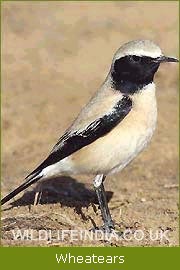 Important
species are Western Tragopan, Satyr Tragopan, Blyth's Tragopan, Temminick's
Tragopan, Monal Pheasant, Sclater's Monal, Tibetan Eared Pheasant, Cheer Pheasant,
Blood Pheasant, Kalij Pheasant, Koklass Pheasant, Red Jungle fowl. One other
species found is the Ibisbill.
Important
species are Western Tragopan, Satyr Tragopan, Blyth's Tragopan, Temminick's
Tragopan, Monal Pheasant, Sclater's Monal, Tibetan Eared Pheasant, Cheer Pheasant,
Blood Pheasant, Kalij Pheasant, Koklass Pheasant, Red Jungle fowl. One other
species found is the Ibisbill.The Western Himalayas is rich in its birdlife and some 500 species of birds are found in this region. The other hotspot area is Eastern Himalayas, one of the richest bird areas in India where some 536 bird species have been identified (Ali 1977).
3. Desert -The extremely arid area west of the Aravalli hill range, comprising both the salt desert of Gujarat and the sand desert of Rajasthan covers 6.9 % of the country's landmass. The Thar Desert is one of the smallest deserts in the world, but it has a wide variety of habitats and biodiversity. Some 250 to 300 species of birds have been reported from this area. Some of the important species to be seen are highly endangered Great Indian Bustard, the migrant Houbara Bustard, various species of Sandgrouse, raptors, wheatears, larks, pipits & munias. Rann of Kutch acts as important breeding ground for both Greater and Lesser Flamingo's.
4. Semi - arid- The zone between the desert and the Deccan plateau, including the Aravalli hill range falls under this. This region has a sizable population of finches, munias, larks, doves & pigeons. Some of the species seen are the Green Munia, the Rock Bush Quail, Malabar Crested Lark, the Syke's Crested Lark, the Indian Chat and the highly endangered the Lesser Florican.
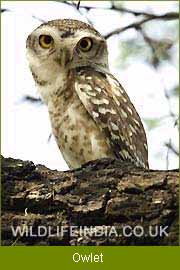
5. Western Ghats -The hill ranges and plains running along the western coastline, south of Tapti river, covering an extremely diverse of biotic provinces and biomes falls under this. One of the two hot spots of India, this area has around 500 species of birds including 16 endemic species found in this area only. Some important birds of the Western Ghats are Wynaad Laughing Thrush, Nilgiri Laughing Thrush, Nilgiri Pipit, the Broad-tailed Grass-Warbler, Nilgiri Wood Pigeon, Malabar Grey Hornbill.
6. Deccan Peninsula - The Deccan Peninsula has some of the finest Dry Deciduous Forests, particularly in Madhya Pradesh, Orissa and Maharashtra. Some important bird species found in this region are Grey Jungle Fowl, Painted Francolin, Rock Bush Quail, Yellow-throated Bulbul, highly endangered Forest Owlet, Jerdon's Courser, Green Munia, the Lesser Florican & the Great Indian Bustard.
7. Gangetic Plains - Defined by the river Ganges, these plains are relatively homogenous. This region is famous for its flood plain wetlands and the marshes. Some of most important wetland birding areas are found in this region. The bird species to be seen are Marsh Warbler, Bristled Grass-Warbler, Rufus-rumped Grass-warbler, Yellow-bellied Prinia, Swamp Francolin, Bengal Florican, many types of ducks and threatened species like pained Storks, Black-necked Stork, Black-headed Ibis & Black-bellied tern.
8. North-East India - North East India is
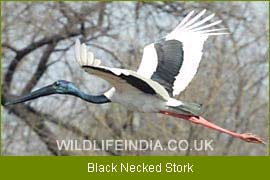 one of the two hot spots of India and covers 5.2 % of the land mass. This area
has some 5800 plant species out of which around 2000 are endemic. At least 55
flowering plants are endemic to this area and is known for the origin of 5 palms
of commercial importance namely, coconut, arecanut, palmgra palm, sugar palm
& wild date palm. 63 % of the genera of land mammals in India are known
from this area and more than 60 % of India's birds are recorded in North East.
Some important birds of this region are Spot-billed Pelican, Oriental White
Stork, both Greater and lesser Adjutant, White-winged Duck, Pallas Fish Eagle,
Swamp Francolin, Manipur Bush-Quail, Green Peafowl, Purple Wood-Pigeon, Rufous-necked
Hornbill, Marsh Babbler, Jerdon's Babbler, Mishmi Wren-Babbler, Hodgson's Prinia
and many more endangered species.
one of the two hot spots of India and covers 5.2 % of the land mass. This area
has some 5800 plant species out of which around 2000 are endemic. At least 55
flowering plants are endemic to this area and is known for the origin of 5 palms
of commercial importance namely, coconut, arecanut, palmgra palm, sugar palm
& wild date palm. 63 % of the genera of land mammals in India are known
from this area and more than 60 % of India's birds are recorded in North East.
Some important birds of this region are Spot-billed Pelican, Oriental White
Stork, both Greater and lesser Adjutant, White-winged Duck, Pallas Fish Eagle,
Swamp Francolin, Manipur Bush-Quail, Green Peafowl, Purple Wood-Pigeon, Rufous-necked
Hornbill, Marsh Babbler, Jerdon's Babbler, Mishmi Wren-Babbler, Hodgson's Prinia
and many more endangered species.9. Islands - The Andaman & Nicobar Islands form 0.25 % of the land mass of the India sub-continent but contribute 12 % of the endemic avifauna of the region (Sankaran 1998). Some unique species found in these islands are Nicobar Megapode, Edible-nest Swiftlet, Narcondam Hornbill, Andaman Serpent-Eagle, Andaman Wood-Pigeon, Andaman Scops-owl, Andaman Hawk-owl, Andaman Black Woodpecker, Andaman Drongo, Andaman Treepie, Andaman Cuckoo Dove, Nicobar Parakeet, Nicobar Sparrow Hawk, Nicobar Bulbul and many other birds.
10. Coasts - Not much study has been done on the birds of the coastline except for some isolated studies in Maharashtra.
:: Click Here For Ramsar Sites in India : :
| :: Birding
in India :: India Birding || Endemic Species of India || Ramsar Sites in India || Birding Map of India || India Bird Check List |



